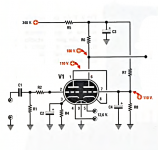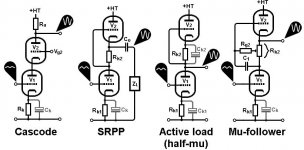I was looking for a simple tube preamp schematic and found in one
old Italian electronics magazine an amp with this circuit
tube input, which they call CASCODE, so it would be
the classic SRPP.
But this pattern is totally different from the others I've seen
and it is not a printing error because the connections are also in the PCB
they are the same, so that's it.
So what is the TRUE CASCODE / SRPP ??
Sorry for any google translate errors...
old Italian electronics magazine an amp with this circuit
tube input, which they call CASCODE, so it would be
the classic SRPP.
But this pattern is totally different from the others I've seen
and it is not a printing error because the connections are also in the PCB
they are the same, so that's it.
So what is the TRUE CASCODE / SRPP ??
Sorry for any google translate errors...
Attachments
A cascode is a common-cathode stage with a common-grid stage on top (or the equivalent with transistors). It has nothing to do with an SRPP stage.
The behaviour of a cascode circuit with two triodes is in many ways similar to a pentode common-cathode stage, but without the partition noise. It was used a lot in high frequency circuits.
The behaviour of a cascode circuit with two triodes is in many ways similar to a pentode common-cathode stage, but without the partition noise. It was used a lot in high frequency circuits.
ahahahah!!!!!!😆
so the mistake is mine !!!!
Let me ask last question:
which of the two has the warmer sound?
I want to build a simple line preamp but i want a warm sound
because my ears don't like brillant sounds.👎
so the mistake is mine !!!!
Let me ask last question:
which of the two has the warmer sound?
I want to build a simple line preamp but i want a warm sound
because my ears don't like brillant sounds.👎
I suppose the tube is ECC83/12AX7. An SRPP will have lower output impedance and lower gain than a cascode. It also needs a better filtered PSU, because it has low PSRR. A cascode is usually followed by a cathode follower to get low output impedance, while an SRPP inherently has low output impedance. The cascode has less maximum voltage output than an SRPP.
Warmer is the sound where 2nd harmonic distortion dominates over 3rd and higher.no!!!!!!!
I need to know because my ears can cheat me
I think it is the cascode.
But it can be tested in LTSpice.
Just for my benefit, what is an SRPP? I have seen almost every circuit topology in existence including tubes, transistors and fets, but all these abbreviations drive me nuts.
Series regulated push-pull or something like that. It's a circuit where a common-cathode stage is connected to a load via a resistor and the voltage across that resistor drives another valve that's connected between the supply and the load. Together they work as a push-pull stage. It used to be used in transformerless output stages driving 800 ohm loudspeakers, for example.
They are all analyzed in merlin blencove's book :no!!!!!!!
I need to know because my ears can cheat me
Designing High-Fidelity Valve Preamps
this is exactly what they wrote in the magazine. So that's true!!Warmer is the sound where 2nd harmonic distortion dominates over 3rd and higher.
I think it is the cascode.
But it can be tested in LTSpice.
Thanks to all!
Now I search for a solid-state PSU because I don't have filters, chokes, tube rectifiers, or wathever you want....
I use SRPP in my phono/line preamplifier because I prefer neutral sound over warm 😉 (and low output impedance too...). But in my power amplifier I use a cascode because it is best suited for the purpose there. Each has its place.
WOW!!! Thank you!!!
But......please
someone has to take away this great curiosity:
why all these schema are with a inverted output??
I am obsessed: in my opinion a preamp cannot have an inverted output.
Why should I make my speakers work in reverse ??
I do not like it at all.
But......please
someone has to take away this great curiosity:
why all these schema are with a inverted output??
I am obsessed: in my opinion a preamp cannot have an inverted output.
Why should I make my speakers work in reverse ??
I do not like it at all.
- Home
- Amplifiers
- Tubes / Valves
- A strange SRPP

